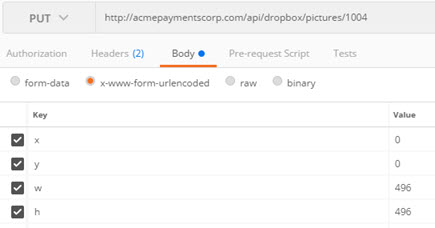PUT /api/dropbox/pictures/{PictureID}
Specifies the display and crop dimensions for a picture previously uploaded to the Dropbox for a resource such as a user profile, app, or API.
For a training exercise that uses this operation, including video, see Example: Adding an App Avatar.
Authorization Roles/Permissions: Must be logged in. Must be either an authorized user for the resource or a Site Admin.
This topic includes the following sections:
HTTP Method
PUT
URL
https://{hostname}/api/dropbox/pictures/{PictureID}
Sample Request
The example below assigns a specific image, previously uploaded to the Dropbox, to the database.
Sample Request URL
https://{hostname}/api/dropbox/pictures/1004
Sample request headers
PUT /api/dropbox/pictures/1001 HTTP/1.1
Host: {hostname}
Accept: application/json, text/javascript, */*; q=0.01
Content-Type: application/x-www-form-urlencoded; charset=UTF-8
X-Csrf-Token_acmepaymentscorp: TokenID%3D8ed70a13-8469-11e8-b37a-b155e4eabeb8%2CexpirationTime%3D153...
Sample request body
The request body contains the URL-encoded form parameters specifying the X and Y values, and dimensions, for the portion of the uploaded image to be used for the user's avatar. An example of how the request body parameters might look in the Postman client application is shown below.

Request Headers
For general information on request header values, refer to HTTP Request Headers.
| Header | Description |
|---|---|
| Accept | application/json, application/vnd.soa.v71+json, application/vnd.soa.v72+json, application/vnd.soa.v80+json, application/vnd.soa.v81+json |
| Content-Type | application/x-www-form-urlencoded |
| Cookie | AtmoAuthToken_{fedmemberid}={cookie value, which usually starts with TokenID}—The platform cookie. This is the Akana API Platform authorization token, and must be sent with every API request that requires login. For more information and an example, see Session cookies. |
| X-Csrf-Token_{fedmemberID} | The CSRF prevention header; may or may not be required, depending on platform settings. See CSRF Prevention on the Platform. By default, the CSRF header is not required for GET operations and is required for all others, with a few exceptions relating to user login. |
Request Parameters
| Parameter | Parm Type | Data Type | Required | Description |
|---|---|---|---|---|
| pictureId | Path | long | Required | The temporary ID assigned to the picture by the Dropbox when the picture is uploaded. |
| h | Form | long | Required | The height of the cropped picture. |
| w | Form | long | Required | The width of the cropped picture. |
| x | Form | long | Required | The starting X-axis position for the cropped picture. |
| y | Form | long | Required | The starting Y-axis position for the cropped picture. |
Response
If successful, this operation returns HTTP status code 200. There is no response content.
Sample Response
The sample response below shows successful completion of the operation.
Sample response headers
HTTP/1.1 200 OK Date: Thu, 15 Jun 2017 21:08:13 GMT
Sample response body
None.
Response Headers
For general information on response header values, refer to HTTP Response Headers.
| Header | Description |
|---|---|
| Content-Type | application/json, application/vnd.soa.v71+json, application/vnd.soa.v72+json, application/vnd.soa.v80+json, application/vnd.soa.v81+json |
Response Body
None.
Error Codes/Messages
If the call is unsuccessful an error code/message is returned. One or more examples of possible errors for this operation are shown below.
| Item | Value |
|---|---|
| 401 | Unauthorized. For example, you would get this response if you didn't include the custom X-Csrf-Token_{fedmemberID} header in the request, when it was required by the platform settings; or if you included an invalid or expired value for this header. You would also get this response for any operation that requires login (almost all) if the login cookie was missing. |
| 405 | Method Not Allowed. You might get this if there is an error in the URL, or if you used the wrong HTTP verb. |
| 500 | An error occurred processing the call. |
More information about Akana API Platform API error messages.